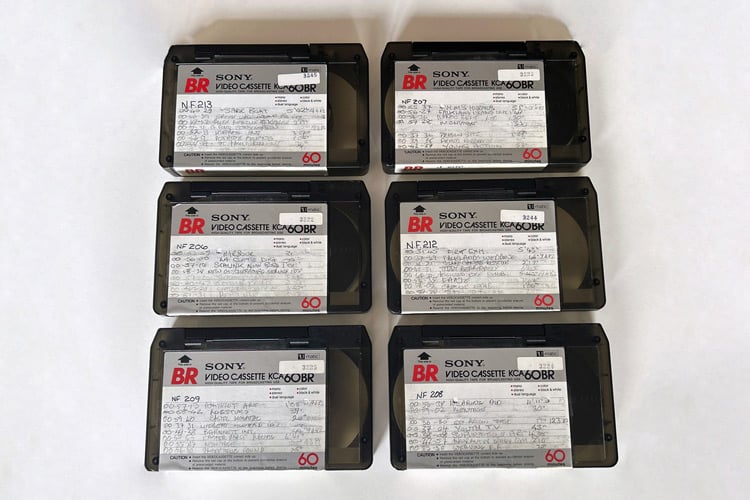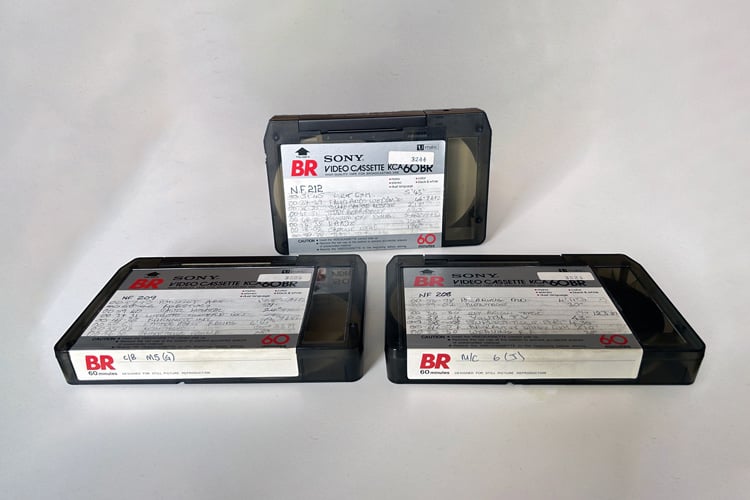
There are a number of reasons for considering the digitisation of your Audio Visual (AV) material. Some of the most inaccessible heritage content is trapped within videotape and audio cassette format. Once a popular and common material, the equipment necessary to access it has been succeeded by more advanced forms of technology.
Whether looking to protect your assets from wear and tear or seeking increased accessibility from your collections, digitisation offers many benefits. Consequently, we have prepared a number of tips for the digitisation of AV material, in particular tape formats. And, because we believe that digitisation is one aspect of a more holistic approach, we have also included some advice on how best to capture your data and where to go to publish your material online.
Short on time? Jump to…
1. Ascertain your AV formats & assess your capabilities
2. Assess for damage & undertake conservation
3. Considering Legacy Hardware
5. Resolution & Colour Calibration
Digitising AV (Videotape & Audio Cassette) Material – Best Practice Tips
1. Ascertain your AV format & assess your capabilities

For well over forty years the videotape captured periods and memories in UK history with a reputation for being one of the easiest and most enduring methods of recording. Over 70 years later this material is in much need of protection. When carrying out digitisation on this type of material, the target format should always be about preservation with technical features retained wherever possible to ensure a complete and authentic copy.
AV material can exist in a range of forms and a typical collection might consist of a variety of different types, all requiring a unique knowledge base in order to handle and capture them safely and effectively. Most media will have its media format written on it. If it’s rectangular and contains black coloured tape, this is a videotape and likely one of the following formats:
- VHS
- VHS-C
- Video8
- Hi8
- Digital8
- MiniDV
- HDV
- MicroMV
- Betamax
- Betacam
- Betacam-SP
- HDCAM
- HDCAM-SR
- DVCPro
If the tape is brown, this is an audio tape. If it’s rectangular it will probably be:
- Audio Cassette
- Micro Cassette
- Mini Cassette
- DAT
If it's circular, it will be an audio reel to reel, which can come in ¼”, ½”, 1” and 2”. These sizes relate to the gauge of the tape (its width).
2. Assess for damage & undertake conservation
Depending on the carrier type and how the carrier has been stored, AV material can suffer degradation. This can vary from minor distortion to the video/audio, all the way to the data no longer being recoverable. Should this happen, the data contained within can be permanently lost. The IASA-TC 06 Guidelines for the Preservation of Video Recordings is a good place to start in terms of safeguarding AV content.
Because digitisation captures images in high resolution even the smallest amount of surface dust can present issues. Therefore, equipment should be monitored for dirt, debris, or misalignment which can result in low RF, screen tearing, audio-visual signal loss, and tracking issues.
Cleaning the equipment
- Clean the heads or transportation decks using either a synthetic chamois cloth or synthetic chamois swab, doused in 100% isopropyl alcohol.
- Compressed air can also be used to dislodge debris inside the chassis or transport mechanism
- Care should be taken not to spray the heads with compressed air from a gas duster because compressed liquids can damage the heads.
Cleaning AV material
Tapes are increasingly at risk of mould, particularly if kept in an environment where the temperature and humidity fluctuate. If mould is identified this presents a health risk and can also contaminate other tapes. The following measures should be taken:
- Items should be immediately transferred to a specialised, easy-to-clean, ventilated environment with a fan extraction fume hood.
- The exterior of the tape should be cleaned first using a specialist vacuum cleaner with a HEPA filter installed to remove any dust or contaminants.
- The tape inside the cassette should be cleaned with specialised cleaning equipment, using a lint-free cloth doused in isopropyl alcohol.
- Care should be taken for formats with a thinner density tape as these are more likely to snap during the cleaning process.
- Tapes affected by mould, to any degree, should be prioritised for data recovery, as there is no guarantee of recovery.
When archiving video tapes, it is recommended to label both the tapes and sleeves with individual identifiers, such as tape numbers or barcodes, to make it easier to associate tapes with their filenames. Most videotapes can be easily removed from their sleeve. However, it is possible that the sleeve has been damaged, disintegrated (in the case of cardboard sleeves), or adjusted in size. In the case of damaged or disintegrating sleeves, it is recommended to transfer the videotape to a new sleeve as soon as possible. In the case of videotapes that cannot be removed from cardboard sleeves, it is recommended that any glue used on the flap of the sleeve be removed, to minimise the risk of ripping.
.jpg?width=1000&height=667&name=twaproj-18-(2).jpg)
3. Considering Legacy Hardware
Only a small amount of legacy video hardware is recommended for use when digitising video, as the quality drastically varies between equipment. For analogue home consumer formats, such as VHS and Video8/Hi8 formats, equipment featuring S-Video output and in-built Time Base Correctors (TBC) are recommended. S-Video separates the luma and chrominance levels of a video signal, resulting in a higher quality image compared to composite output. The TBC corrects when a player does not replicate the exact timing, fixing issues such as screen jitter, colour streaking, dropped frames, and screen tearing.
For DV based formats (DV, MiniDV, DVCam, Digital8, MicroMV, HDV), equipment with a Firewire port is recommended to connect the equipment to a PC to extract the DV file from the tape. Due to the discontinuation of Firewire, legacy computer hardware may be needed to connect the equipment to a PC.
Studio formats require equipment that supports specific formats. Due to the increasing scarcity of these products, along with some formats, such as DVCPro, being notorious for failing hardware, it is recommended to seek professional advice.
4. Equipment & Process
There are comprehensive guidelines for the set-up and processing of AV material and the capture process varies between formats. For analogue formats, equipment should be connected to an external Processing Amplifier (Proc Amp), which allows for the adjustment of black levels, video gain, saturation and hue of a video signal, a TBC, and a Frame Synchroniser. This should then be connected to a capture card that supports lossless encoding and the appropriate video output for each format. Most legacy video formats output an interlaced signal, where each frame of video is split into two images that alternate between each horizontal line. Analogue formats should be captured in their interlaced form, as unnecessary deinterlacing can cause quality degradation and visual artefacts. For situations where deinterlacing is necessary, such as preparing archived video for streaming, the original deinterlaced footage can be kept.
For DV formats, footage is transferred via FireWire. This is because, unlike many other formats, the data on the tape is already digital. However, the digitised information must be transferred to a computer so that the content can be archived.
5. Resolution & Colour Calibration

Standard Definition videotapes should be archived to Digital Television Standards, as follows:
- For videotapes recorded in NTSC territories, footage is captured at 720 x 480 at 60 interlaced frames per second.
- For videotapes recorded in PAL territories, footage is captured at 720 x 576 at 50 interlaced frames per second.
- High Definition formats are recorded at the resolution and frame rate specified on the videotape.
Whilst it is possible to upscale, it is not recommended. Upscaling merely stretches or duplicates individual pixels to fit a larger resolution. When Standard Definition footage is displayed on a higher resolution display, the display will need to upscale the image to fit the entirety of the display, negating the need to upscale footage. Additional issues can occur when upscaling images to higher resolutions too, such as footage appearing cropped or stretched due to the upscaled resolution being an integer of the original resolution.
Issues relating to colour are best attempted to be fixed in the video signal chain. This is achieved using a Proc Amp to ensure that recordings meet the following broadcasting standards:
- Peak white levels of a video signal - Under 100 IRE units
- Black level - 0 IRE units (or 7.5 IRE for US NTSC).
What Next?
Regardless of the format, all AV material is at significant risk of degradation. Tapes that are kept in storage, even in optimum conditions, are highly susceptible to the formation of mould increasing the vulnerability of videotapes, it should be assumed that all videotapes have, to some degree, already begun to degrade. Time is very much of the essence when it comes to AV material, and efforts should be made to capture and preserve this sooner rather than later.
We regularly digitise tapes, cine, and audio. Our digitisation technicians are experienced in handling a wide range of carriers, converting almost all video formats. We also digitise audio cassettes, compact cassettes, reel to reel, and Dictaphone tapes. Whatever form your AV material takes, it is likely that it can be digitised subject to thorough research.
We hope this blog proves helpful in understanding how we digitise your AV content to achieve the exceptionally high standards to which we aspire. Should you wish to discuss any aspect, or you would like to outsource your project to a digitisation specialist, then please do get in touch.




 USE OUR ONLINE
USE OUR ONLINE








